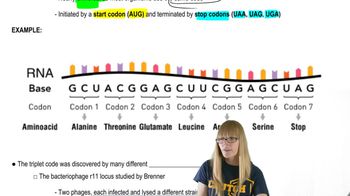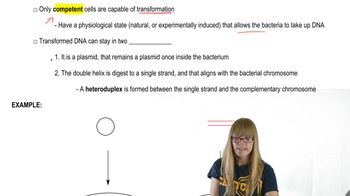Table of contents
- 1. Introduction to Genetics51m
- 2. Mendel's Laws of Inheritance3h 37m
- 3. Extensions to Mendelian Inheritance2h 41m
- 4. Genetic Mapping and Linkage2h 28m
- 5. Genetics of Bacteria and Viruses1h 21m
- 6. Chromosomal Variation1h 48m
- 7. DNA and Chromosome Structure56m
- 8. DNA Replication1h 10m
- 9. Mitosis and Meiosis1h 34m
- 10. Transcription1h 0m
- 11. Translation58m
- 12. Gene Regulation in Prokaryotes1h 19m
- 13. Gene Regulation in Eukaryotes44m
- 14. Genetic Control of Development44m
- 15. Genomes and Genomics1h 50m
- 16. Transposable Elements47m
- 17. Mutation, Repair, and Recombination1h 6m
- 18. Molecular Genetic Tools19m
- 19. Cancer Genetics29m
- 20. Quantitative Genetics1h 26m
- 21. Population Genetics50m
- 22. Evolutionary Genetics29m
11. Translation
The Genetic Code
Problem 3a
Textbook Question
Several lines of experimental evidence pointed to a triplet genetic code. Identify three pieces of information that supported the triplet hypothesis of genetic code structure.
 Verified step by step guidance
Verified step by step guidance1
<span>Step 1: Understand the concept of a triplet genetic code. The genetic code is composed of codons, which are sequences of three nucleotides that correspond to specific amino acids or stop signals during protein synthesis.</span>
<span>Step 2: Consider the experimental evidence from Crick and Brenner's work with frameshift mutations. They demonstrated that inserting or deleting one or two nucleotides in a DNA sequence disrupted the reading frame, but inserting or deleting three nucleotides often restored the reading frame, supporting the triplet nature of the genetic code.</span>
<span>Step 3: Examine the Nirenberg and Matthaei experiment, which used synthetic RNA sequences to determine which amino acids were produced. They found that poly-U RNA (UUU) directed the synthesis of phenylalanine, indicating that specific triplet sequences code for specific amino acids.</span>
<span>Step 4: Review the discovery of the genetic code table, which shows that there are 64 possible codons (4^3 combinations of the four nucleotides: A, U, G, C) and that these codons specify the 20 amino acids and stop signals, further supporting the triplet hypothesis.</span>
<span>Step 5: Reflect on the redundancy of the genetic code, where multiple codons can code for the same amino acid. This redundancy is consistent with a triplet code, as it allows for 64 codons to encode 20 amino acids and stop signals, providing robustness against mutations.</span>
Recommended similar problem, with video answer:
 Verified Solution
Verified SolutionThis video solution was recommended by our tutors as helpful for the problem above
Video duration:
2mPlay a video:
Was this helpful?
Key Concepts
Here are the essential concepts you must grasp in order to answer the question correctly.
Triplet Code
The triplet code refers to the genetic coding system in which sequences of three nucleotides (codons) correspond to specific amino acids. This concept is fundamental in understanding how genetic information is translated into proteins, as each triplet specifies one of the 20 amino acids used in protein synthesis.
Recommended video:
Guided course

The Genetic Code
Experimental Evidence
Experimental evidence supporting the triplet hypothesis includes findings from studies such as those by Marshall Nirenberg and Heinrich Matthaei, who demonstrated that synthetic RNA sequences could direct the incorporation of specific amino acids into proteins. This provided direct proof that codons, composed of three nucleotides, dictate the sequence of amino acids in proteins.
Recommended video:
Guided course

Transformation
Mutational Analysis
Mutational analysis involves studying the effects of mutations on the genetic code. Experiments showed that changes in a single nucleotide could lead to significant changes in the resulting protein, while changes in groups of three nucleotides often resulted in more predictable alterations. This reinforced the idea that the genetic code is read in triplets, as shifts in reading frames could drastically alter protein function.
Recommended video:
Guided course

Chi Square Analysis

 11:43m
11:43mWatch next
Master The Genetic Code with a bite sized video explanation from Kylia Goodner
Start learningRelated Videos
Related Practice

